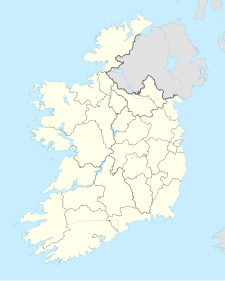| St Conal's Hospital | |
|---|---|
| Health Service Executive | |
 St Conal's Hospital and chapel as seen from Letterkenny Town Park | |
| Geography | |
| Location | Letterkenny, County Donegal,, Ireland |
| Coordinates | 54°57′35″N 7°44′00″W / 54.9596°N 7.7334°W |
| Organisation | |
| Care system | HSE |
| Type | Specialist |
| Services | |
| Emergency department | No |
| Speciality | Psychiatric hospital |
| History | |
| Opened | 1866 |
| Closed | 2010 |
St Conal's Hospital (Irish: Ospidéal Naomh Conaill) was a psychiatric hospital located in Letterkenny, County Donegal, Ireland. Opened in 1866 (as the Donegal District Lunatic Asylum), it had people work on its farm as recently as 1995. The building is still extant.
History


The hospital, which was designed by George Wilkinson in the neo-Georgian style using a corridor layout, was built by Matthew McClelland at a cost of £37,900 and opened as the Donegal District Lunatic Asylum in February 1866.[1] At that time it accommodated 300 patients (150 male and 150 female).[1] It has been described as "one of the finest buildings in the country".[2]
A large new building was erected at the rear of the site in 1912.[3] The facility became the Donegal Mental Hospital in the 1920s and benefited from a new chapel, designed in the neo-Norman style, being erected in the 1930s.[4]
The facility was renamed St Conal's Hospital in 1956.[1] As the hospital expanded nursing staff numbers reached close to 500 in the 1960s.[5] After the introduction of deinstitutionalisation in the late 1980s the hospital went into a period of decline.[6][7] However patients were still required to carry out activities on the hospital's working farm which only closed in 1995.[8] Electroconvulsive therapy (ECT) was still being carried out on patients in the hospital in the late 1990s.[9] The hospital had people work on its farm until 1995.[10]
Seosamh Mac Grianna spent three decades at St Conal's Hospital.[11]
On 27 August 2007, a blaze which broke out at 5:45 pm in a downstairs room took fire services approximately four hours to extinguish.[12] The main hospital closed in 2010.[13][14]
In March 2020, a memorial was to be unveiled at new Leck Cemetery to remember the hundreds of patients whom the Management Committee had buried in unmarked graves there from March 1902, when the means to dispose of their bodies on a site at the back of the hospital grounds ceased.[15] The memorial had been due to be unveiled the previous December but poor weather forecasts prompted its postponement.[15] The practice of burying dead patients there continued late into the twentieth century, almost until the hospital shut.[15]
Since 2015, Lugh Films have been working on a documentary about life behind the hospital walls, intended as a "social history".[10]
During the COVID-19 pandemic, St Conal's Hospital was used as a drive-through test centre.[16]
See also
References
- ^ a b c "150 years of St Conal's Hospital". Donegal Daily. 19 May 2019. Retrieved 19 May 2019.
- ^ "Winds of change at St. Conal's Institution". The Letterkenny and District Christmas Annual (1992 edition), p. 27.
- ^ "HSE buildings is still boarded up - but could it get a new lease of life?". Donegal Daily. 6 November 2015. Retrieved 19 May 2019.
- ^ "History of Letterkenny". Station House Hotel. Retrieved 19 May 2019.
- ^ "The History of St. Conal's Hospital". The Letterkenny and District Christmas Annual (1990 edition), p. 16.
- ^ "After the Asylum". Irish Times. 13 July 2013. Retrieved 29 May 2019.
- ^ Cotter, Noelle (2009). "Transfer of Care? A Critical Analysis of Post-Release Psychiatric Care for Prisoners in the Cork Region" (PDF). University College Cork. p. 5. Retrieved 29 May 2019.
- ^ "Last of the St Conal's Workers retires". Donegal News. 13 October 2017. Retrieved 19 May 2019.
- ^ Scanlon, Cronan (15 May 2015). "Former psychiatric patient protests against electric shock treatment". Archived from the original on 16 May 2015.
- ^ a b Sharkey, Conor (27 February 2020). "Film company developing documentary exploring the history of St Conal's Hospital". Donegal News. p. 37.
- ^ "Not a Glaswegian, not a Galwegian but a true Letterkenny man!". The Leader. August 2020. p. 6.
[Little John Nee] followed up with 'The Mental' which tells the story of Joe Boyle who finds himself in St Conal's Hospital and reflects on the life of the Irish language writer, Seosamh MacGrianna[sic], who had spent 30 years there, and other residents of the Letterkenny establishment.
See online version and https://theleader.ie/ - ^ Letterkenny Post, Thursday 30 August 2007.
- ^ "Hospital closures pave way for new mental health premises at Portrane". Irish Times. 8 July 2014. Retrieved 29 May 2019.
- ^ "Under the Clock Towers – an overview of remaining 19th century public psychiatric hospitals due for closure" (PDF). Mental Health Commission. 2011. p. 21. Retrieved 19 May 2019.
- ^ a b c Walsh, Harry (1 March 2020). "Memorial to be unveiled at new Leck cemetery". Donegal News. Retrieved 1 March 2020.
- ^ "COVID-19 Test Centre opens in Letterkenny". Donegal News. 19 March 2020. Retrieved 19 March 2020.


